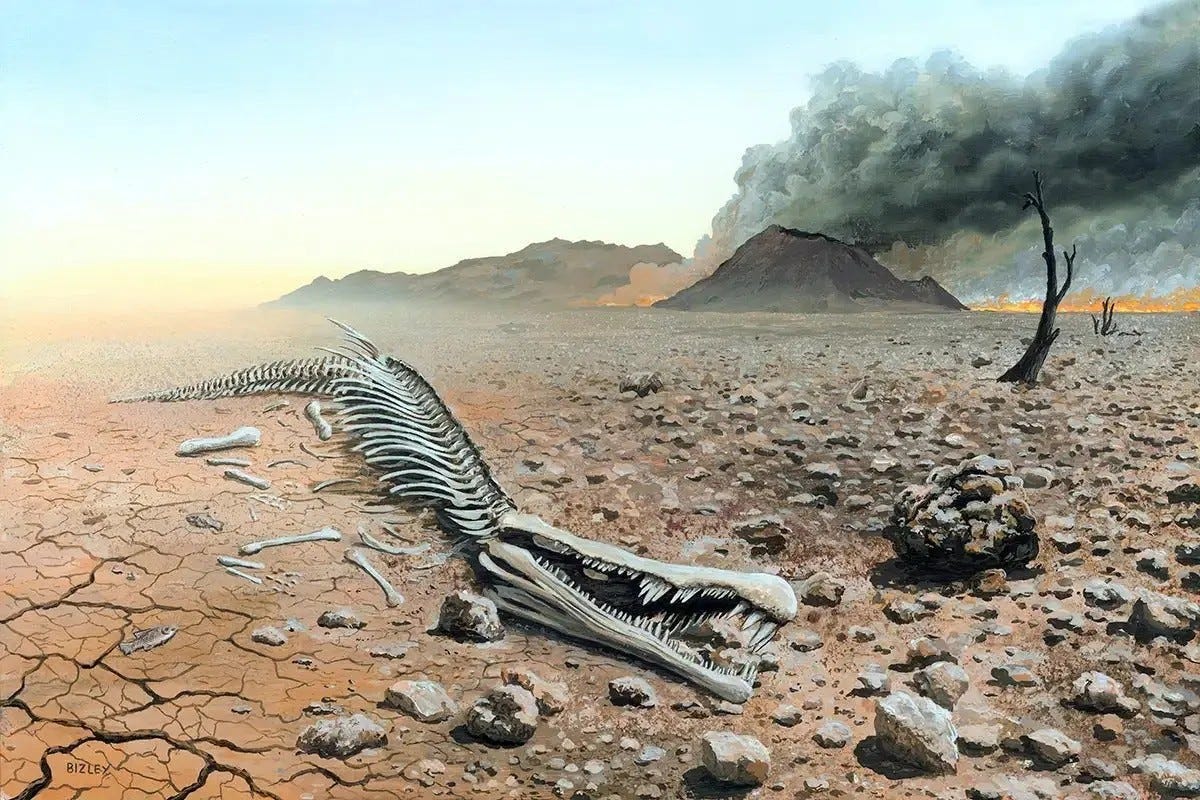
Let’s continue our discussion about MASS EXTINCTION. Since we are now living through the Sixth Extinction Event.
Which is about to get much worse.
There have been 5 MAJOR Mass Extinction (ME) events over the last 500my.
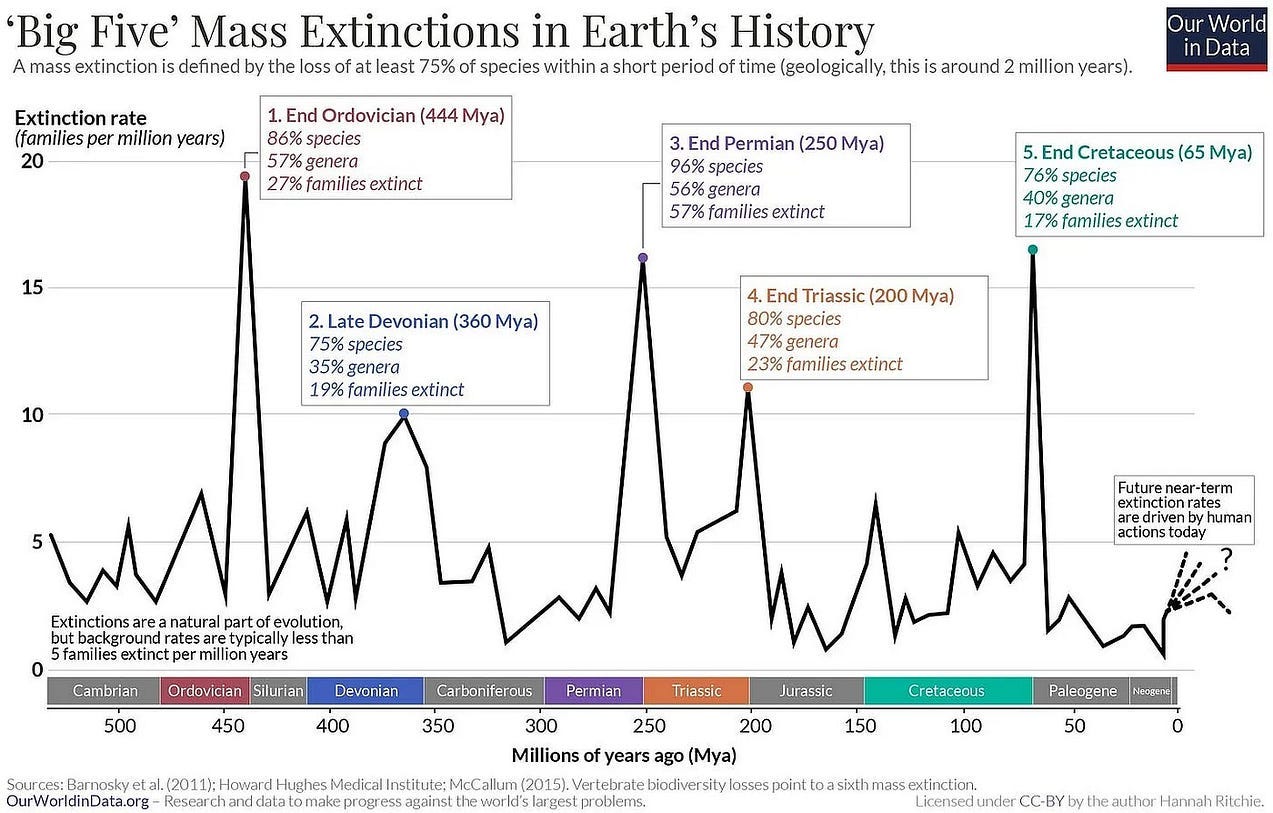
These extinction events stand out from the normal background extinction rate of typically less than 5 families per million years.
Just to be clear a “family” is different from a species. Species actually go extinct all the time as part of the continuing evolution of the Earth. Things CHANGE and with change there are winners and losers.
It’s estimated that the normal background rate of species extinction is around 1 extinction per million species per year (E/MSY). This means, for example, that if there were a million species on Earth, one would be expected to go extinct naturally each year.
Currently Harvard biologist E. O. Wilson estimates that 30,000 species per year (or three species per hour) are being driven to extinction.
A conservative estimate (Climate change extinctions, Science, 5 Dec 2024, Vol 386, Issue 6726, pp. 1123–1128 DOI: 10.1126/science.adp4461) is that:
A third of Earth's species could become extinct by 2100 if climate change isn't curbed
An analysis of research on most known species around the world finds climate change puts many species at risk of…www.livescience.com
That estimate is -30% of species at +5.4°C (+9.7°F) of warming, a high estimate for warming, but one that is possible even though it seems extreme right now. Particularly if all you are hearing is MSM climate news.
Families are MUCH bigger than species. Here's an analogy to help visualize the difference.
Imagine a family tree:
Each individual person (e.g., you, your sibling, your parent) represents a SPECIES
Your immediate family (including parents, siblings, and children) represents a GENUS.
Your extended family (aunts, uncles, cousins, etc.) would be like a FAMILY.
Different extended families (e.g., your mother’s side, your father’s side) would be like different families within an ORDER.
In essence, a family encompasses a broader range of organisms than a species, grouping together related species based on shared characteristics and evolutionary history.
The difference between a species going extinct and a family going extinct is like the difference between someone killing just you. Or someone killing you, your wife, your kids, your parents, your grandparents, your aunts, your uncles, and ALL your first cousins.
It's a MUCH bigger deal when families of organisms go extinct than it is when a species goes extinct.
During the GREAT DYING of the Permian/Triassic Mass Extinction 250mya, 96% of species AND 56% of FAMILIES went extinct. The biosphere shrank by around 90% from the beginning of the event to its peak.
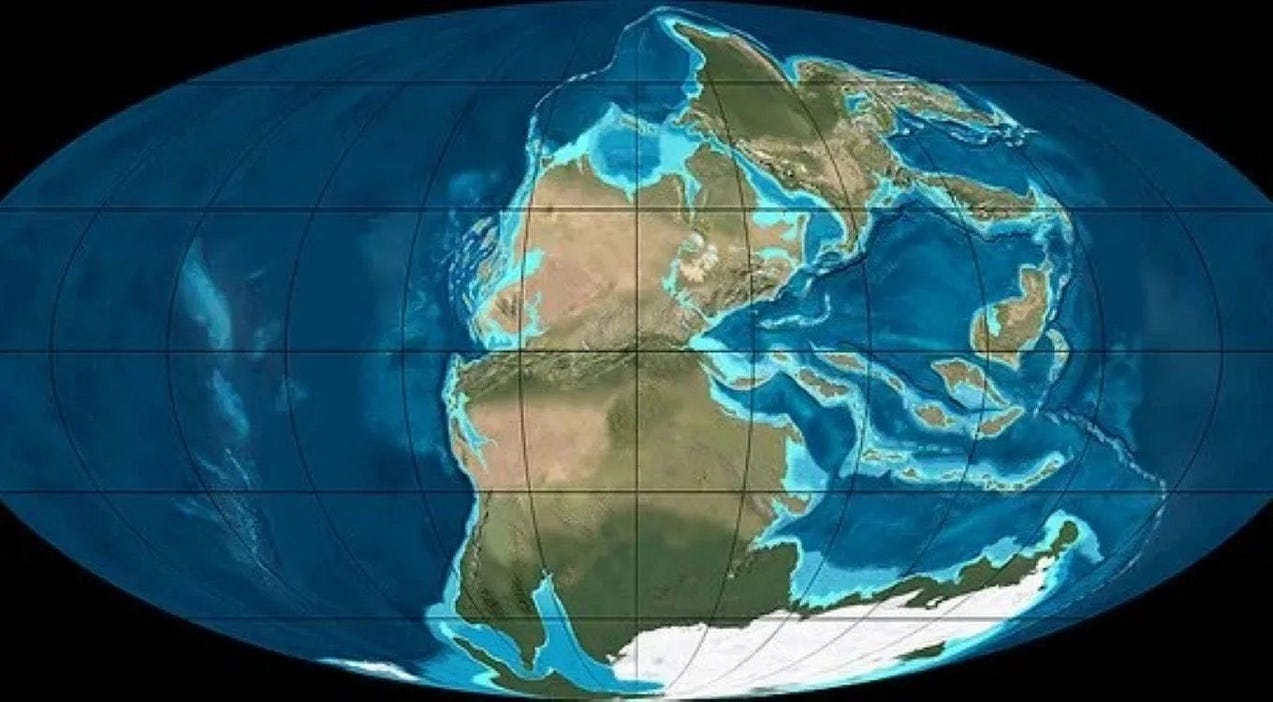
It was the first “land centric” mass extinction event. The previous two ME’s had primarily affected life in the oceans since there really wasn’t any life on land to speak of. Since the Devonian ME of 350mya a 100my had passed and LIFE had colonized the land.
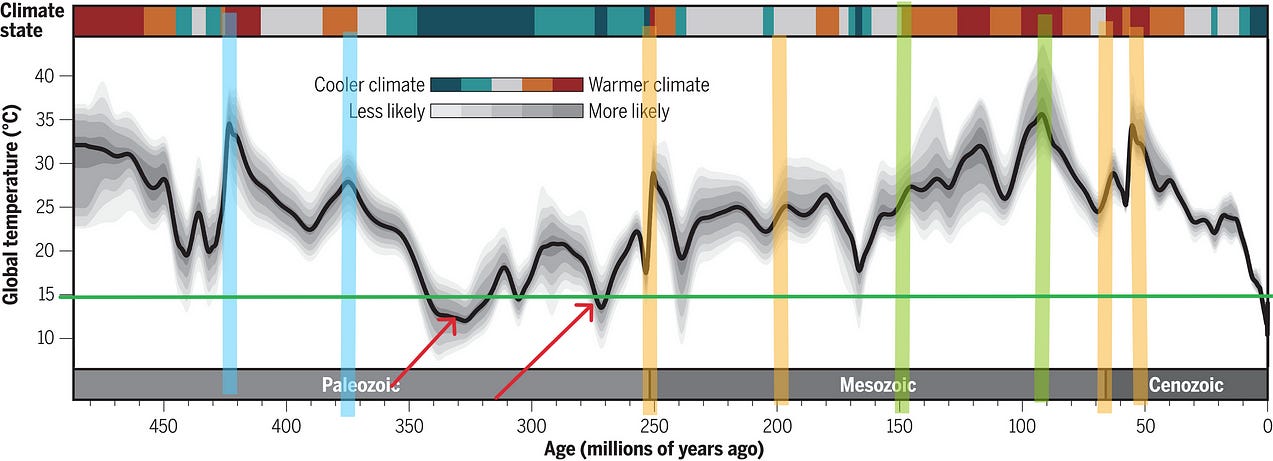
We can see the effect of this colonization and carbon sequestration in the paleoclimate fossil record. See the RED arrows, those are ICEHOUSE climate states when the Earth got as cold as it has been for the last 2–3 million years in our age. Plants pulled so much CO2 out of the superheated atmosphere that the Earth cooled down to about the same place we are now, DESPITE the volcanic activity that was going on during this period.
Then an apocalypse came along and wiped out a world that had existed for over 100 million years.
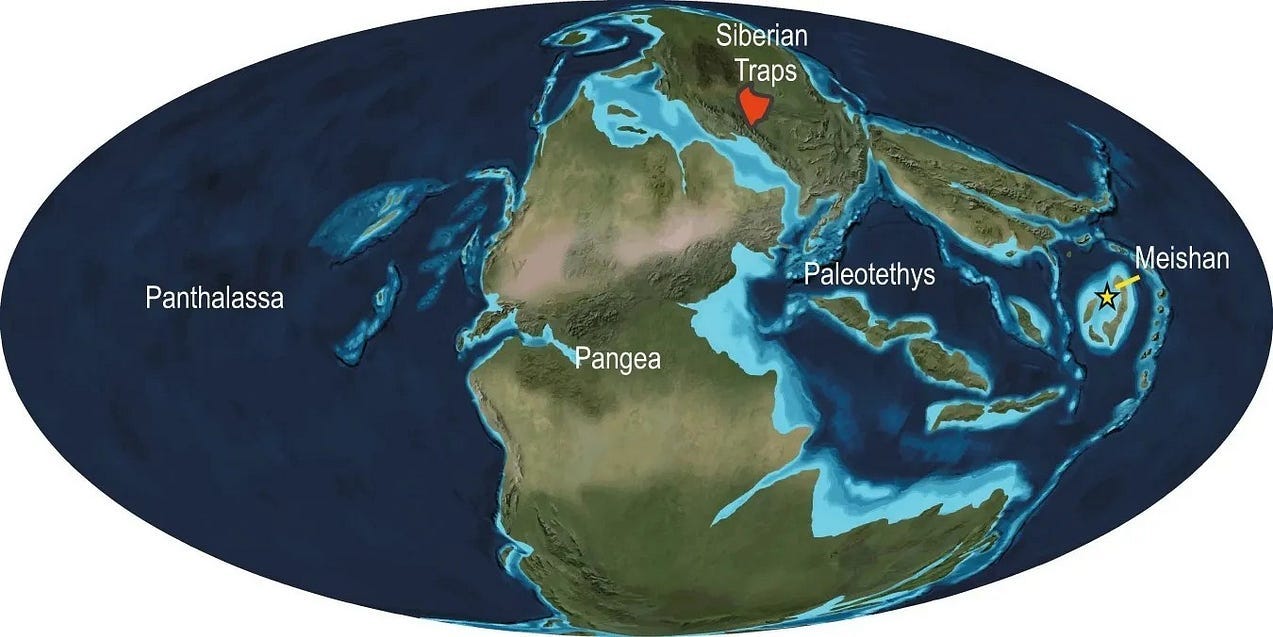
The WORST part of it happened right at the beginning, during the first 75,000 years.
“We show that pCO2 increased from 426ppm(CO2) in the latest Permian to 2507ppm(CO2) at the Permian-Triassic Mass Extinction within about 75ky, and that the reconstructed pCO2 significantly correlates with sea surface temperatures.” — Field evidence for coal combustion links the 252 Ma Siberian Traps with global carbon disruption — June 2020
CO2 levels “shot up” from 426ppm to +2500ppm within about 75,000 years. Say, roughly 2100ppm over 70,000 years. That's a rate of increase that averages out to about +2.8ppm PER CENTURY.
For comparison:
Based on the annual analysis from NOAA’s Global Monitoring Lab, the global average atmospheric carbon dioxide was 422.8ppm in 2024, a new record high. The increase during 2024 was +3.75 ppm. The LARGEST one-year increase on record.
The current rate of CO2 increase is 132 TIMES faster than the catastrophic warming that triggered the “Great Dying”.
During this increase in CO2 levels a “tipping point” was crossed and things suddenly got MUCH WORSE. Around 860ppm(CO2) the tropical forests started dying out, the coral reefs vanished, and the plankton populations the oceans collapses.
Early Triassic super-greenhouse climate driven by vegetation collapse - Nature Communications
The Permian-Triassic Mass Extinction (PTME), the most severe crisis of the Phanerozoic, has been attributed to intense…www.nature.com
Mega El Niño events may have caused planet's greatest mass extinction | CNN
Mega El Niños could have intensified the world's most devastating mass extinction, which ended the Permian Period 252…www.cnn.com
As atmospheric partial pressure of carbon dioxide doubled from about 410 to about 860 ppm (parts per million) in the latest Permian, the meridional overturning circulation collapsed, the Hadley cell contracted, and El Niños intensified.
The resultant deforestation, reef demise, and plankton crisis marked the start of a cascading environmental disaster. Reduced carbon sequestration initiated positive feedback, producing a warmer hothouse and, consequently, stronger El Niños. The compounding effects of elevated climate variability and mean state warming led to catastrophic but diachronous terrestrial and marine losses.
From: Mega El Niño instigated the end-Permian mass extinction — Science, Sept 2024
The “cascading environmental disaster” started at around +860ppmCO2. FAR below the +2500ppmCO2 level that would ultimately be reached.
To be CLEAR, CO2 levels of +860ppm represent a +12°C (+21°F) increase in the Global Mean Temperature OVER the GMST of 13.9°C (57°F) that we had in 1850 at CO2 levels of 280ppm.
In the paleoclimate record for the last 500my, going from 280ppm(CO2) to 860ppm(CO2) raises the GMST from around +14°C (57°F) to around +26°C (78°F). At which point the biosphere begins to rapidly die IF this increase happens too quickly.
Because there have been times when the GMST was VERY HIGH and yet species die-off was fairly low. Barely higher than the normal background extinction rate.
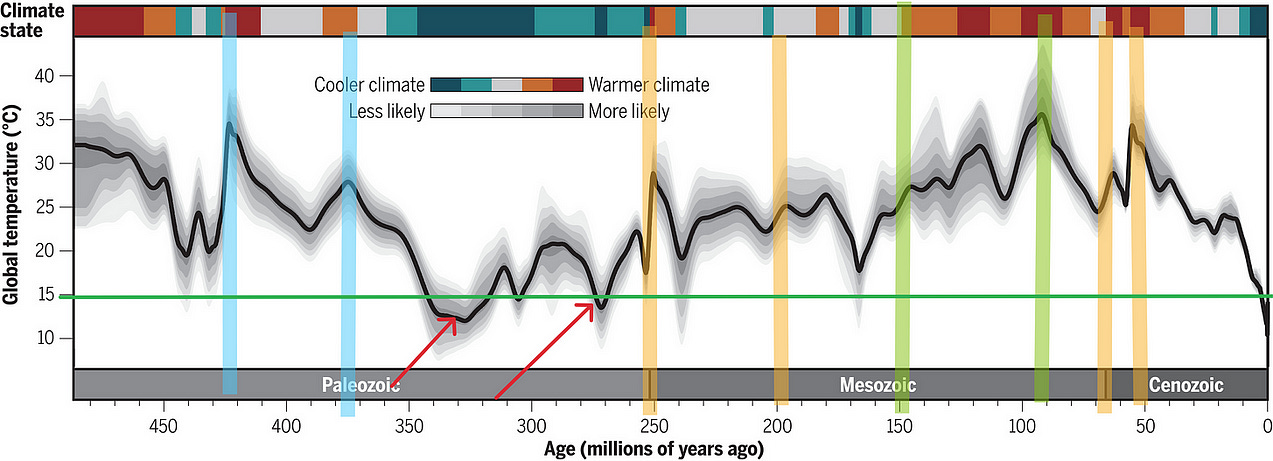
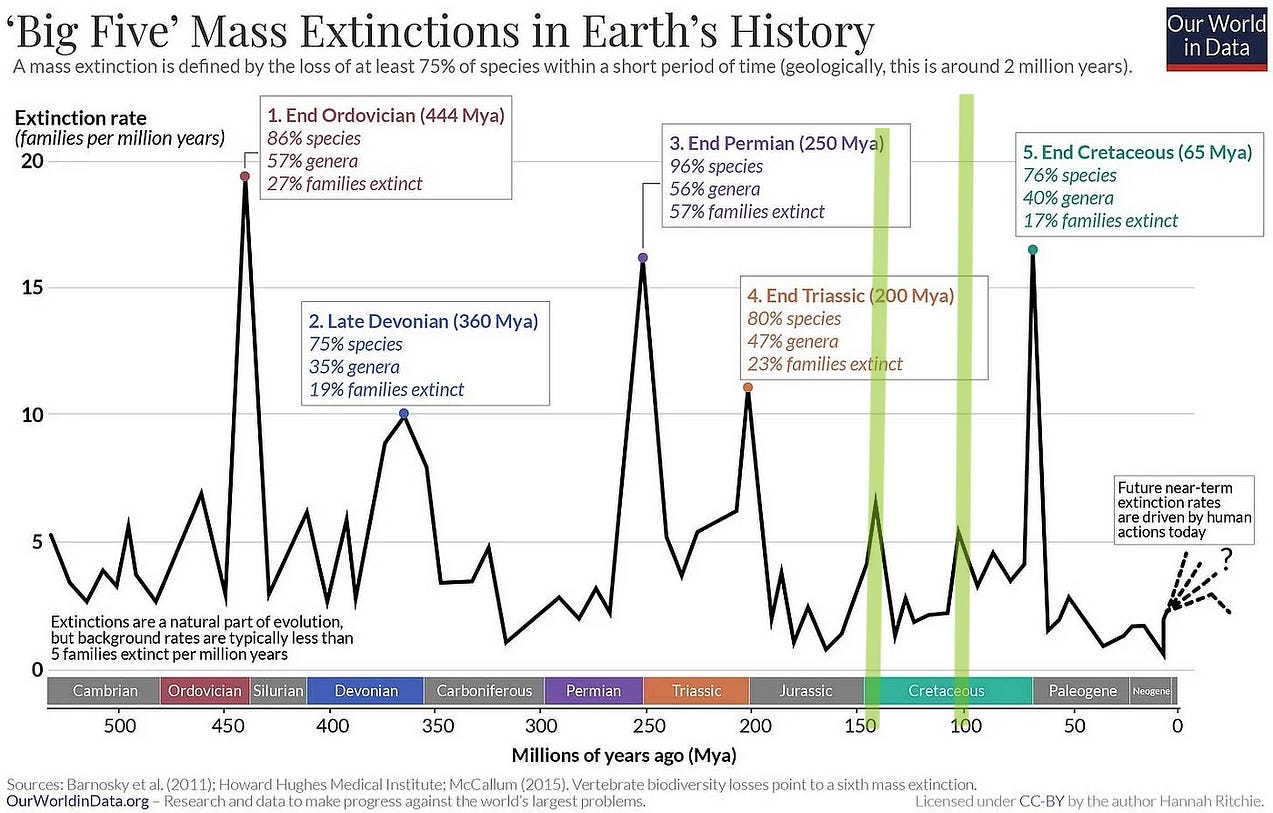
So, the lesson of the Permian-Triassic “Great Dying” is that SPEED MATTERS. The difference between a HOT world that’s flourishing and full of life and a denuded desert world that's barren seems to be HOW FAST the planet warms up. Particularly how fast it goes from CO2 levels in the mid 400’s to the mid 800's.
When it happened too quickly during the Permian, life between 30°N and 30°S DIED.
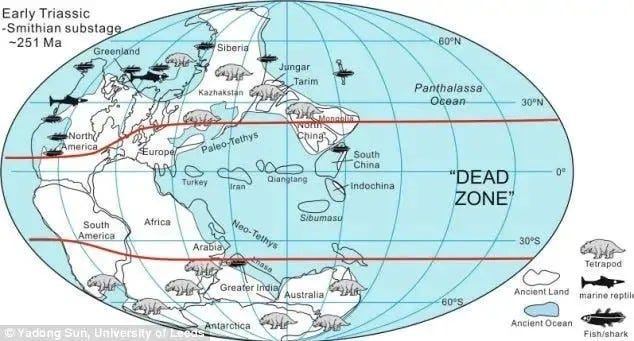
Then 50 million years later. It happened again.
· Triassic-Jurrasic Extinction: 201 million years ago.
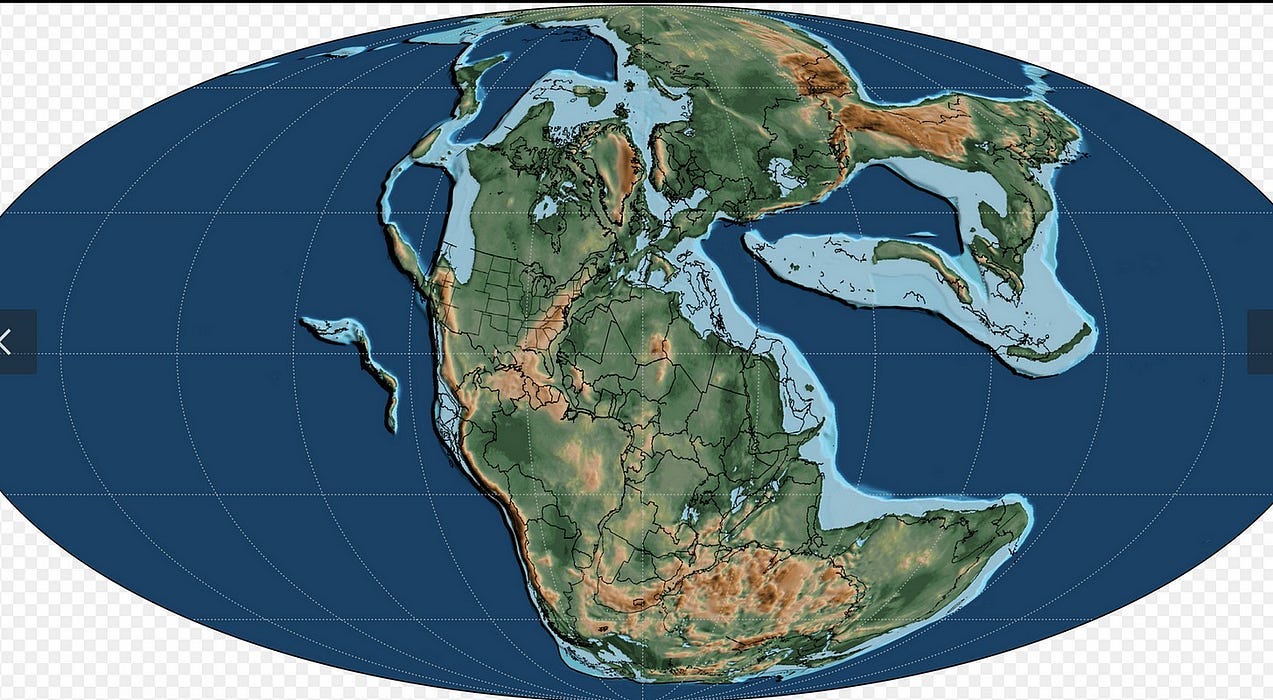
The Triassic-Jurassic Event was FAST in geologic terms.
Huge and widespread volcanic eruptions triggered the end-Triassic extinction
Some 200 million years ago, an increase in atmospheric CO2 caused acidification of the oceans and global warming that…news.mit.edu
We now know that over a relatively short period of time, massive volcanic eruptions from a large region known as the Central Atlantic Magmatic Province (CAMP) spewed forth huge amounts of lava and gas, including carbon dioxide, sulfur and methane.
This sudden release of gases into the atmosphere created intense global warming and acidification of the oceans that ultimately killed off thousands of plant and animal species.
Using igneous rocks from the CAMP eruptions as well as sedimentary rocks that accumulated in an enormous lake that existed for several million years. Researchers used a combination of techniques to date the rocks and to pinpoint the beginning and duration of these volcanic episodes.
By using geochronology and astrochronology techniques to date the lake sediments researchers were able to obtain precise estimates for the onset of volcanism 200 million years ago. The sediments revealed that there were three SHORT INTENSE bursts of magmatic activity during a 40,000 year period.
From these measurements researchers discovered that the eruption of magma, along with carbon dioxide, sulfur and methane, occurred in repeated bursts over a period of just 40,000 years. A relatively short span in geologic time.
During this exceptionally SHORT period of time. MASSIVE amounts of carbon dioxide and other gas emissions drastically altered Earth’s climate, killing off thousands of plant and animal species.
“This extinction happened at a geological instant in time. There’s no question the extinction’s started occurring at the same time as the first eruption.” — Sam Bowring, the Robert R. Shrock Professor of Geology in MIT’s Department of Earth, Atmospheric and Planetary Sciences.
In terms of causing a Mass Extinction event speed was apparently the critical factor.
In the seas, about 23–34% of marine genera disappeared; corals, bivalves, brachiopods, bryozoans, and radiolarians suffered severe losses of diversity and conodonts were completely wiped out, while marine vertebrates, gastropods, and benthic foraminifera were relatively unaffected.
On land, all archosauromorph reptiles other than crocodylomorphs, dinosaurs, and pterosaurs became extinct. Crocodylomorphs, dinosaurs, pterosaurs, and mammals were left largely untouched, allowing them to become the dominant land animals for the next 135 million years.
Plants were likewise significantly affected by the crisis, with floral communities undergoing radical ecological restructuring across the extinction event.
- Wikipedia
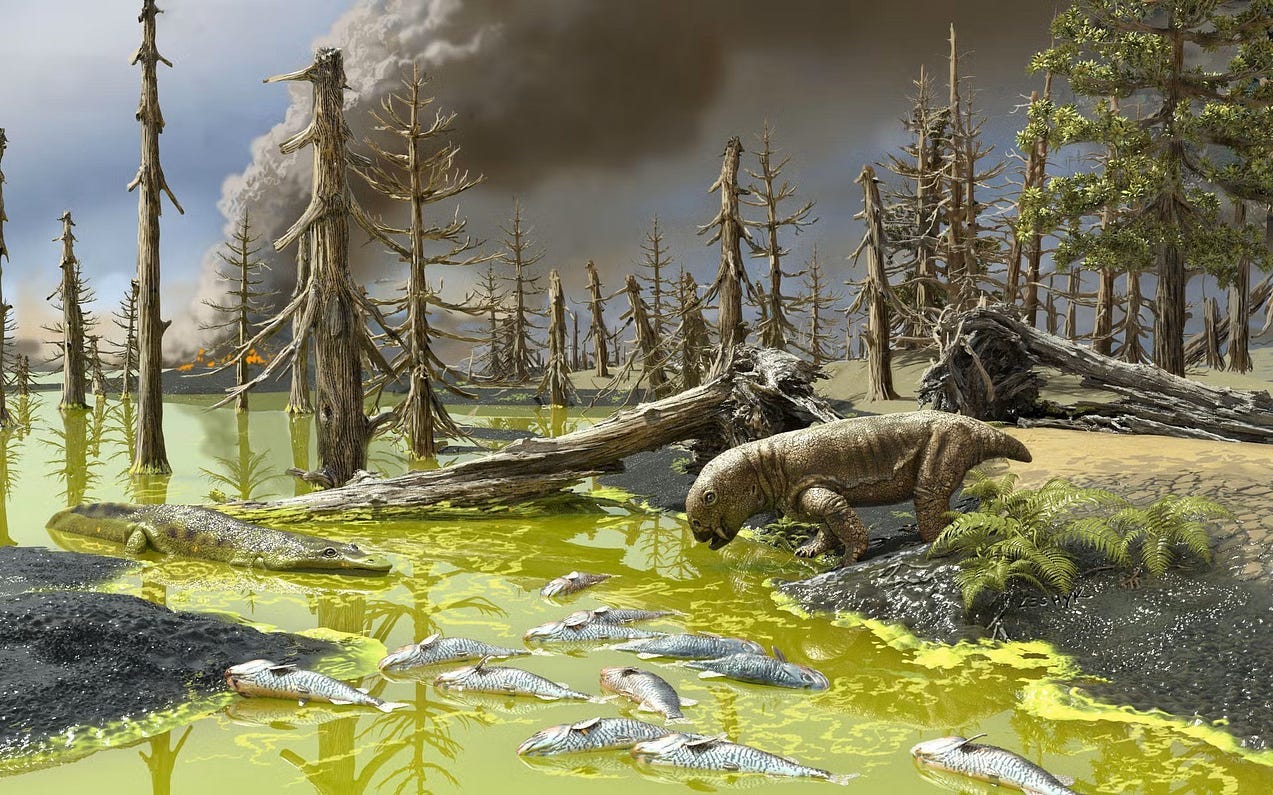
Here’s a description of what paleontology tells us the world was like during the peak of the extinction event from the book “Under a Green Sky: Global Warming, the Mass Extinctions of the Past, and What They Can Tell Us About Our Future” (Peter Ward, 2007)
“No wind in the 120-degree morning heat, and no trees for shade. There is some vegetation, but it is low, stunted, parched. Of other life, there seems little. A scorpion, a spider, winged flies, and among the roots of the desert vegetation we see the burrows of some sort of small animals — the first mammals, perhaps.”
“The largest creatures anywhere in the landscape are slim, bipedal dinosaurs, of a man’s height at most, but they are almost vanishingly rare, and scrawny, obviously starving. The land is a desert in its heat and aridity, but a dune less desert, for there is no wind. The land is hot barrenness. Yet as sepulchral as the land is, it is the sea itself that is most frightening.”
“Waves slowly lap on the quiet shore, slow-motion waves with the consistency of gelatin. Most of the shoreline is encrusted with rotting organic matter, silk-like swaths of bacterial slick now putrefying under the blazing sun. We look out on the surface of the great sea itself, and as far as the eye can see there is a mirrored flatness, an ocean without whitecaps.”
“Yet that is not the biggest surprise”
“From shore to the horizon, there is but an unending purple color — a vast, flat, oily purple, not looking at all like water, not looking like anything of our world. No fish break its surface, no birds or any other kind of flying creatures dip down looking for food. The purple color comes from vast concentrations of floating bacteria, for the oceans of Earth have all become covered with a hundred-foot-thick veneer of purple and green bacterial soup.”
“At last there is motion on the sea, yet it is not life, but anti-life. Not far from the fetid shore, a large bubble of gas belches from the viscous, oil slick-like surface, and then several more of varying sizes bubble up and noisily pop. The gas emanating from the bubbles is not air, or even methane, the gas that bubbles up from the bottom of swamps. It is hydrogen sulfide, produced by green sulfur bacteria growing amid their purple cousins.”
Hydrogen sulphide poisoning of shallow seas following the end-Triassic extinction - Nature…
The evolution of complex life over the past 600 million years was disrupted by at least five mass extinctions, one of…www.nature.com
“There is one final surprise.”
“We look upward, to the sky. High, vastly high, overhead there are thin clouds, clouds existing at an altitude far in excess of the highest clouds found on our Earth. They exist in a place that changes the very color of the sky. We are under a pale green sky, and it has the smell of death and poison.”
“We have gone to the Nevada of 200 million years ago only to arrive under the transparent atmospheric glass of a greenhouse extinction event, and it is poison, heat, and mass extinction that are found in this greenhouse.”
All of that from CO2 levels levels doubling from the high 700’s (about +10°C over our 1850 baseline of 14°C) to around 1400ppm (about +18°C over our 1850 baseline) over a 40,000 year timeframe.
Basically, the Earth became so hot that few plants or animals could survive in the equatorial and tropical regions.
Or pretty much what happened during the Permian Mass Extinction.
By 2050 we will be at around 750ppmCO2e. At a +3ppm/year rate of increase we will reach 860ppmCO2e around 2085.
Assuming things don’t accelerate.
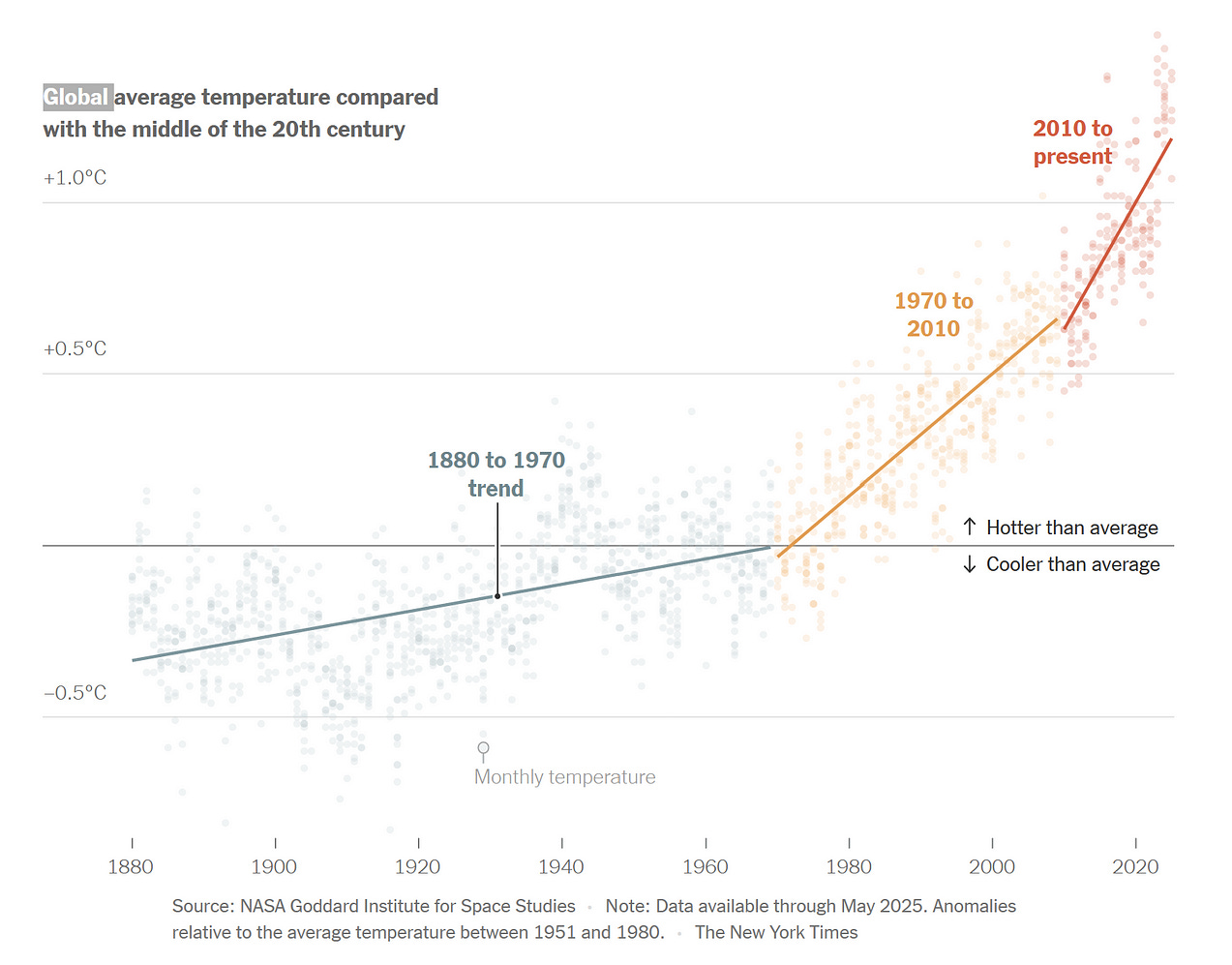
860ppm(CO2e) represents a +12°C warmer world than our 1850 baseline or a world where the GMST is around 26°C (79°F).
That’s Triassic-Jurassic Mass Extinction event levels.
It took 40,000 years of volcanic eruptions to boost CO2 levels enough to cause +8°C of warming during that event.
We did it in about 150.
THINGS ARE GOING TO RAPIDLY GET WORSE NOW.
We have “tipped”.
End Part Two.
This is my analysis.
This is what I see.
This is my “Crisis Report”.
rc 07/20/2025
ADDENDUM:
This is the part that people aren’t getting yet. The “just how really BAD we f’ed up”. Here's a SHORT outline of what's happening.
Let’s start with “ecosystem turnover”.
036 — The World’s Forests are Burning, Ecosystem Turnover is the Cause. Let’s All be Really Clear on What that Means.
Notice the strip of dark green at the top of the Northern Hemisphere. That’s the Boreal Forests. We worry about the Amazon and forests in Indonesia, but the Boreal Forests hold more Carbon than all the other forests in the world COMBINED.
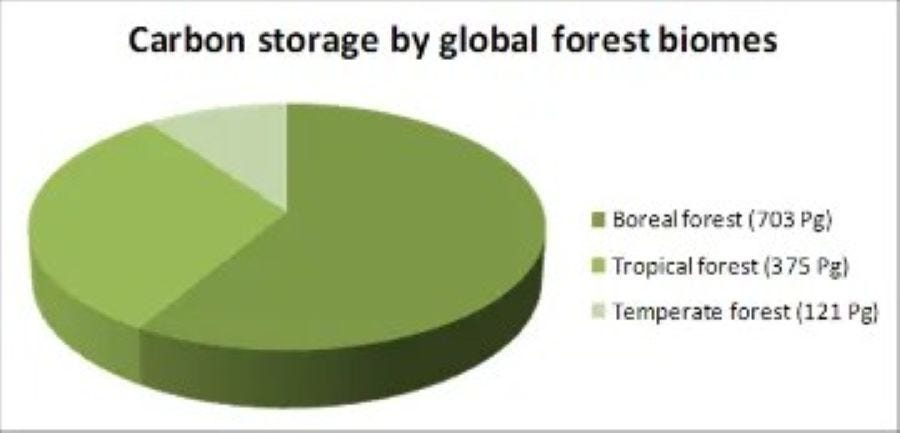
ALL of Boreal Forests are projected to burn.
In Alaska for example, researchers in 2019 made a projection: By the middle of this century, Alaska’s forests, now dominated by spruce, would give way to forests of deciduous trees, like birch, aspen, and cottonwood. Their conclusion,
“We’re going to lose every single spruce tree in Southcentral Alaska”.
After they die they are going to BURN and release the carbon they are sequestering.
The organic matter that the permafrost suppresses is estimated at around 1,672 gigatonnes. Which is equivalent to all of the organic carbon contained in ALL of the land plants on the WHOLE planet PLUS what’s in the atmosphere at this moment.
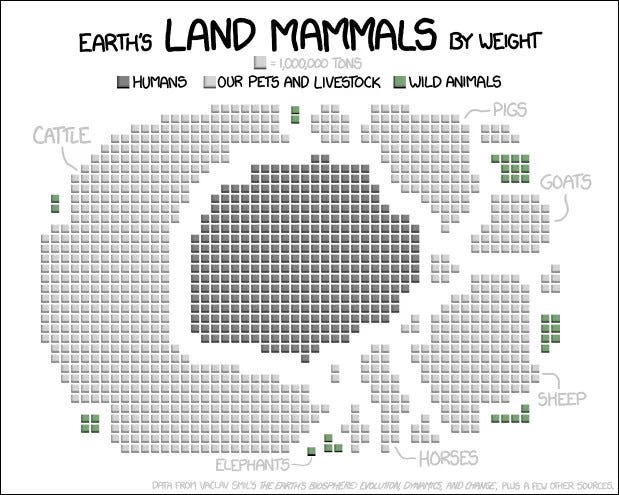
The Boreal Forests standing on top of the permafrost zone are estimated to be storing around 700–800 gigatonnes tons of carbon.
There is enough sequestered carbon in the Boreal Forests to raise CO2 levels around +100ppm. That's not counting the Amazon or other global forests.
Each year during the spring and summer you can literally SEE the Boreal Forests “breath in” and suck CO2 out of the air. These forests take in billions of tons of human-released greenhouse gases. “Eating” roughly 1/6 of CO2 emissions from the burning of fossil fuels and the loss of forests around the world. Then “sequestering” this carbon in the form of bio-mass.
Or at least they used to.
Because the High Arctic is warming up “faster than expected” and these forests are starting to die.
Now, we have known since the 60’s that most of the ENERGY going into the Climate System happens around the Equator.
80% of the ENERGY in the Climate System starts in the Tropics. Above latitude 40°N and 40°S the other areas of the planet LOSE more ENERGY than they take in. ENERGY in the Climate System moves from the Equatorial zone to the Poles.
The question has always been, what happens to it after it gets there?
From the 70’s on, it has been understood that this ENERGY gets to the poles and builds up. It “accumulates” and Accumulation is a form of AMPLIFICATION.
Hence the term “Arctic Amplification”.
This isn’t so much of a problem for the South Pole but researchers have always been VERY concerned about the North Pole.
WHY?
Ummm…go back and look at the forest map. There is a shitload of forest and permafrost around the Arctic Ocean that you don’t have in Antarctica.
There is around 750,000 years of accumulated organic carbon in the Northern permafrost. It has been sequestering carbon for a LONG time which makes it a potential “carbon bomb” if it melts.
Climate Science has known about this since the 70’s but didn’t get around to trying to set an “official” value for Arctic Amplification in climate models until 1998.
See: Latitudinal temperature gradients and climate change.
JOURNAL OF GEOPHYSICAL RESEARCH, VOL. 103, NO. D6, PAGES 5943–5971, MARCH 27, 1998 by David Rind NASA\GISS
FYI- this was a HUGELY influential paper, it was a major effort by GISS to set this value for the General Climate Models going forward and they also discredited paleoclimate research in this paper. See my article CR:050 — The Earth’s Climate System — A Short Users Guide. Part 03. Permafrost Melting — The role of permafrost in the Climate System. (07/01/23) for details.
There were three main theories.
The North Pole would just ‘eat’ the extra HEAT ENERGY.
2. The temperature at the North Pole would go up, “slightly”.
3. The temperature at the North Pole would go up, “A LOT”.
What was starting to scare Climate Scientists in 1998, was that they had believed the answer would be #1 or #2. But new fossil evidence, indicated it was #3.
In 1998 mainstream climate science decided that #2 would be their answer.
Here are Rind’s conclusions.
“Future climate projections from different (Climate) models show substantial differences in the projected latitudinal temperature response from anthropogenic greenhouse perturbations”.
“Doubled CO2 equilibrium simulations from different atmosphere-mixed layer ocean models show different degrees of high-latitude climate warming amplification.”
“In the GFDL model (Alarmist), the temperature response at high latitudes is 3–4 times that at the equator.”
“While in the GISS model (Moderate), it is only close to a factor of 2 [Rind, 1987a].”
“The regional response in these different models depends on these differences in equator-to-pole gradients, which affects the hydrologic cycle, in general, and storm energetics [Rind, 1987a, 1988].”
Translation — EVERYTHING, “kinda” depends on how this works.
Rind and NASA/GISS had a CHOICE here. Between an ALARMIST model they didn’t “agree” with, and their model which produced results in-line with their expectations.
They picked their own model. What did you think would happen?
That was very influential. NASA/GISS is regarded as the “Gold Standard” in Climate Science. It became an accepted FACT that this would be the “expected” amount of “Arctic Amplification”.
High-Latitude Climate Warming Amplification should ONLY be “close to a factor of 2”.
Reality says “they were WRONG”.
Because the Arctic is warming a LOT faster than the rest of the Earth.
The Arctic has warmed nearly four times faster than the globe since 1979 …..Communications Earth & Environment — volume 3, Article number: 168 (Aug 2022)
In recent decades, the warming in the Arctic has been much faster than in the rest of the world, a phenomenon known as Arctic amplification.
Numerous studies report (based on models) that the Arctic is warming either twice, more than twice, or even three times as fast as the globe on average.
Here we show, by using several observational datasets (REAL collected DATA) which cover the Arctic region.
That during the last 43 years the Arctic has been warming nearly four times faster than the globe, which is a higher ratio than generally reported in literature.
We compared the observed Arctic amplification ratio with the ratio simulated by state-of-the-art climate models, and found that the observed four-fold warming ratio over 1979–2021 is an extremely rare occasion in the climate model simulations.
The observed and simulated amplification ratios are more consistent with each other if calculated over a longer period; however the comparison is obscured by observational uncertainties before 1979.
Our results indicate that the recent four-fold Arctic warming ratio is either an extremely unlikely event, or the climate models systematically tend to underestimate the amplification.
Yah think?
NASA/GISS TOLD everyone in 1998 to use a LOW value for Amplification and so EVERYONE did. EVERYONE assumes that NASA/GISS knows what they are talking about.
No one questions the “scientific consensus” because if you do, why then, ‘you’re a DOOMER’.
However, it gets WORSE.
Not only is the High Arctic warming up 4 times faster than the rest of the planet there is something called the Latitudinal Equator to Pole Temperature Gradient and Latitudinal Response.
Remember the title of the 1998 paper isn’t “Setting a value for Arctic Amplification”. It was Latitudinal temperature gradients and climate change. If you have never heard of that, here’s what David Rind a GISS researcher emeritus had to say.
The first sentence of this paper asks.
“How variable is the latitudinal temperature gradient with climate change?”
Then goes on to tell us that;
“This question is second in importance only to the question of overall climate sensitivity.”
“Our current inability to answer it affects everything from understanding past climate variations, and paleoclimate proxies, to projections of regional effects of future greenhouse warming [Rind, 1995].”
So, it’s a BIG DEAL.
Here’s what the current Latitudinal Equator to Pole Temperature Gradient looks like for the Northern Hemisphere.
The “heat loss constant” in this case is -0.62C per degree of latitude.
Meaning, that for every degree North you go away from the Equator, subtract 0.62C of HEAT from the amount you started with. Remember, there are only 90 degrees of latitude between the Equator and each of the Poles.
The North Pole seems cold to us. But 38% of the HEAT ENERGY that starts at the Equator winds up there, and STAYS.
So what happens if you force a HUGE amount of HEAT into the system at the Equator?
That’s what the paper in 1998 is mostly about.
The mainstream consensus in 1998 that you find in textbooks is that this curve remains basically “unchanged”. The thing to remember is that this conclusion was based SOLELY on modeling using the biases and variable values of the Moderate faction in Climate Science.
Is there actual evidence that backs this up?
In 2016 the paleoclimate data came together. It says the mainstream models are full of shit.
Some Thoughts on Global Climate Change: The Transition from Icehouse to Hothouse Conditions
From book: Earth History: The Evolution of the Earth System (2016)
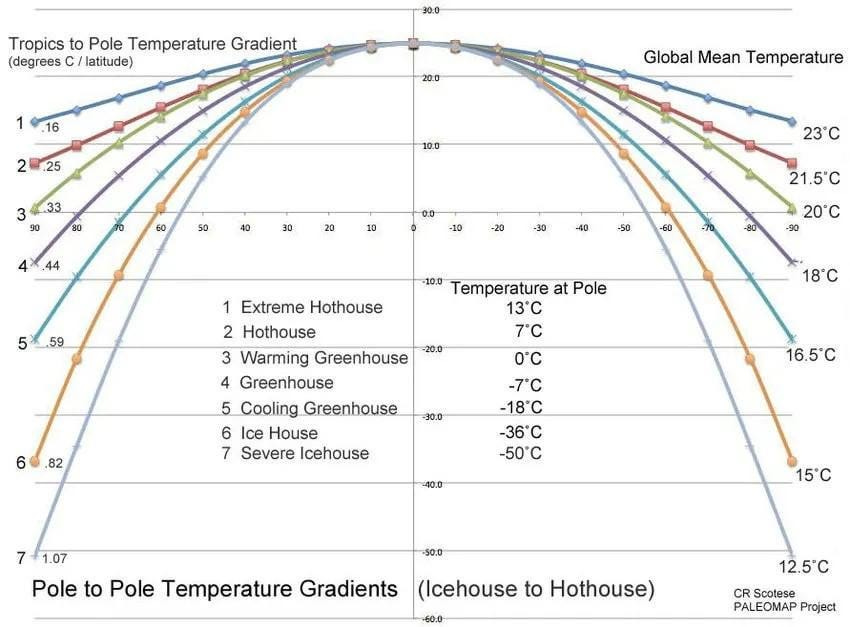
Because the North Pole is warmer than the South Pole they have different “Energy States”. The NP is a “Cooling Greenhouse”, while the SP is a “Severe Icehouse”.
In this graphic there are seven different “climate states” shown for a variety of different periods of the Earth. The Tropics-to-Pole Temperature Gradient is shown for each of these climate states, in both of the two hemispheres.
The way to use the graph, is to pick the state each of the poles is currently in and average the results to get the Global Mean Temperature of the planet. We are currently in a 5/7 configuration, so the GMT should be around 15C (59F). Which, of course, is the current GMT.
Now, what happens if we dump enough CO2 into the atmosphere to raise the GMT by +4C? The amount of warming the paleoclimate record indicates we can expect at a CO2 level of around 420ppm.
Raising the GMT +4C shifts us into a 3/5 climate state.
In the High Arctic temperatures go up about +20C.
The High Arctic where the BOREAL FOREST and PERMAFROST are, will probably warm up about +20°C JUST from the CO2 we have already dumped into the atmosphere.
We aren’t just “warming up” the Arctic.
We have set off a CARBON BOMB.
One that has the potential to boost atmospheric CO2 levels into the 1200ppm to 1500ppm range.
Enough to warm the planet +18°C to a GMST of around 30°C when it “peaks”.
The Boreal Forests are DOOMED.
We are just at the beginning of the GREAT BURNING.
A MASS EXTINCTION has started.
It gets worse from here on out.




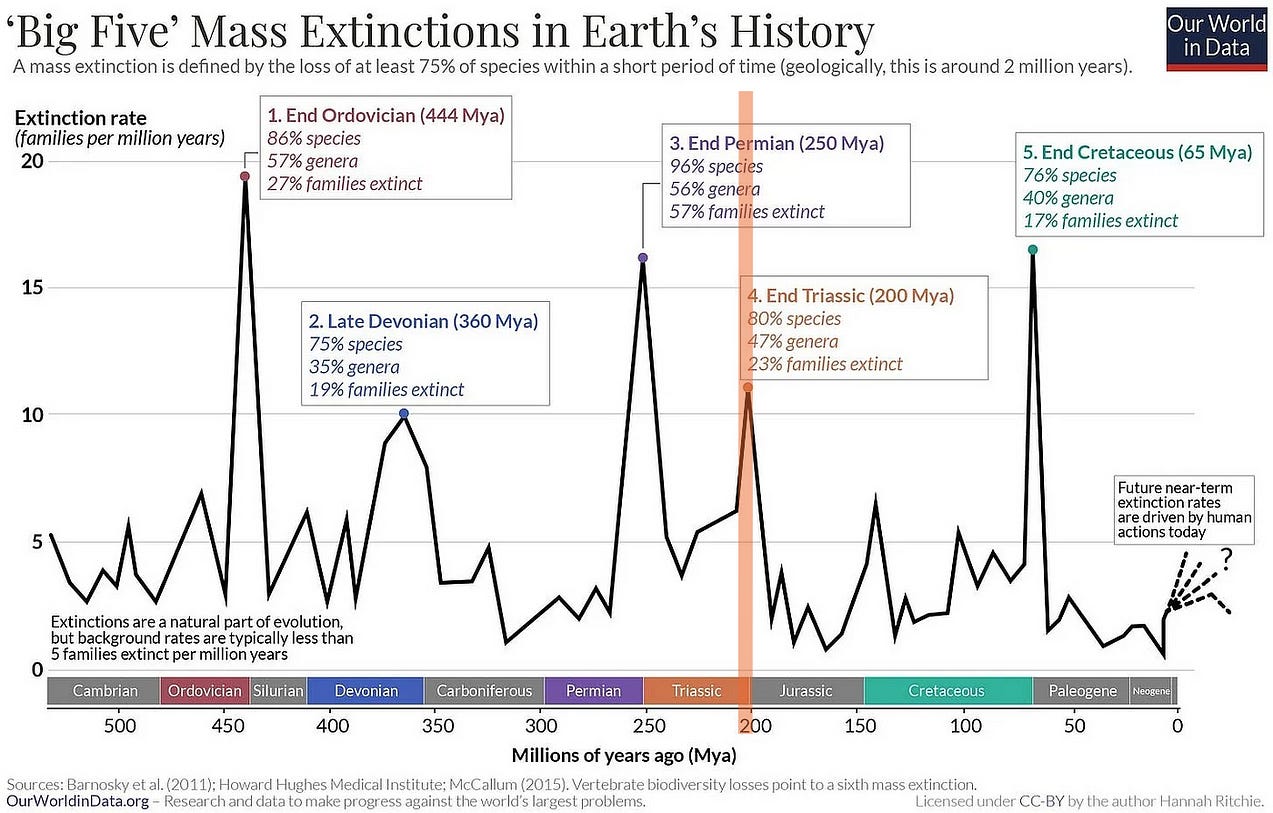
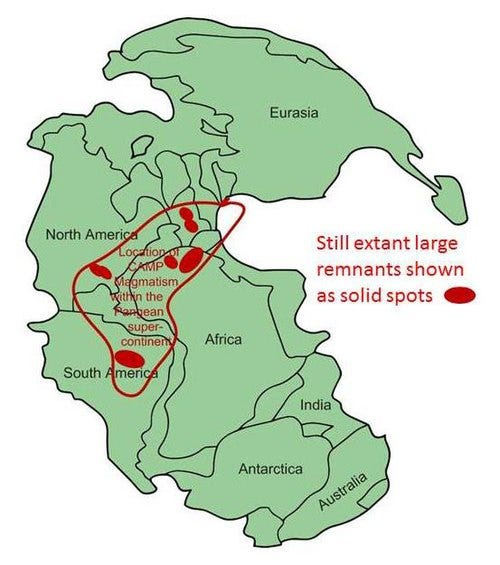
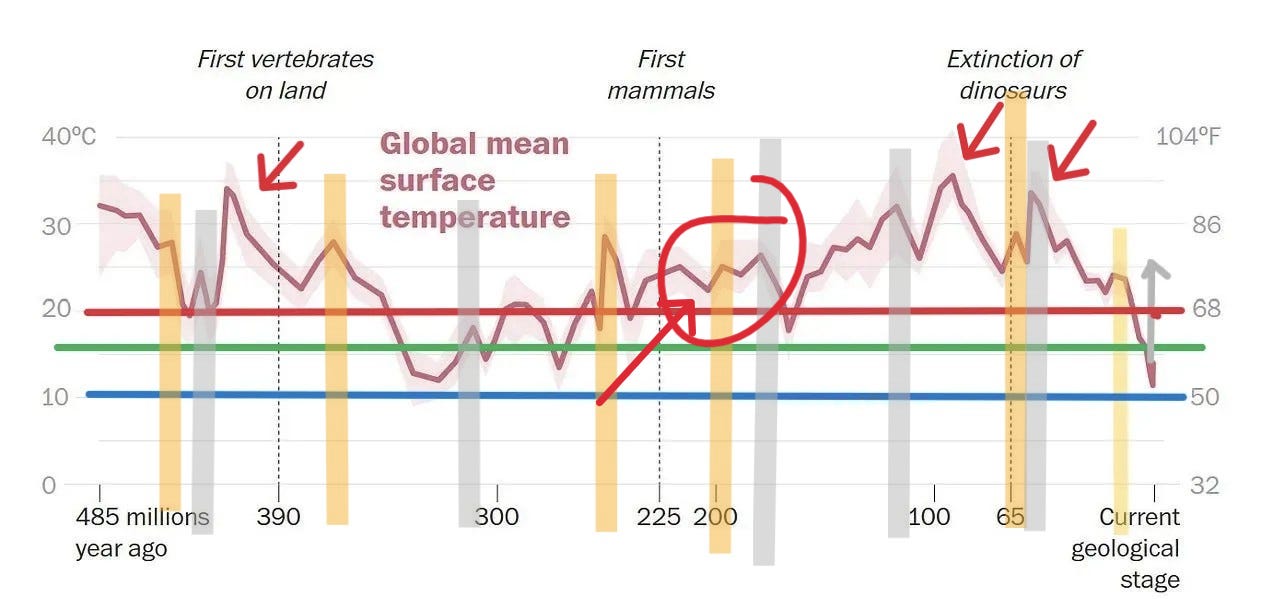
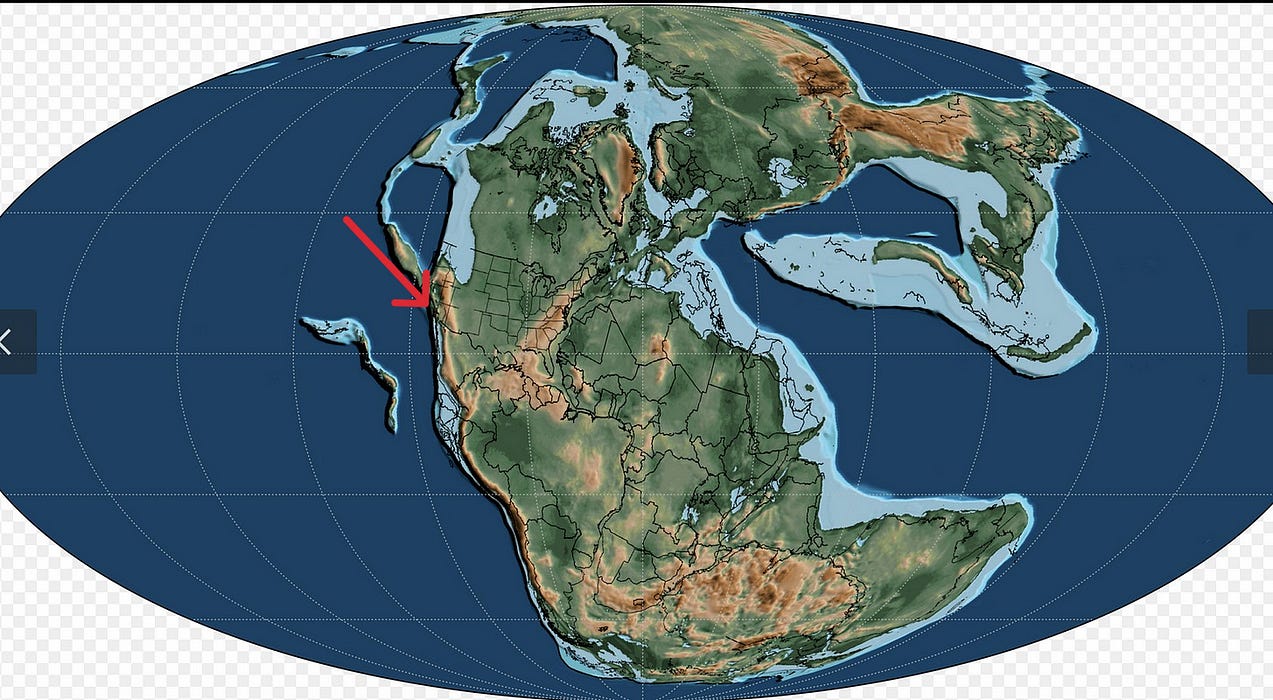
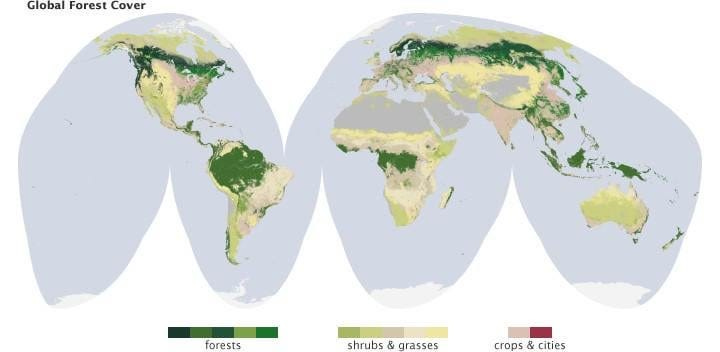
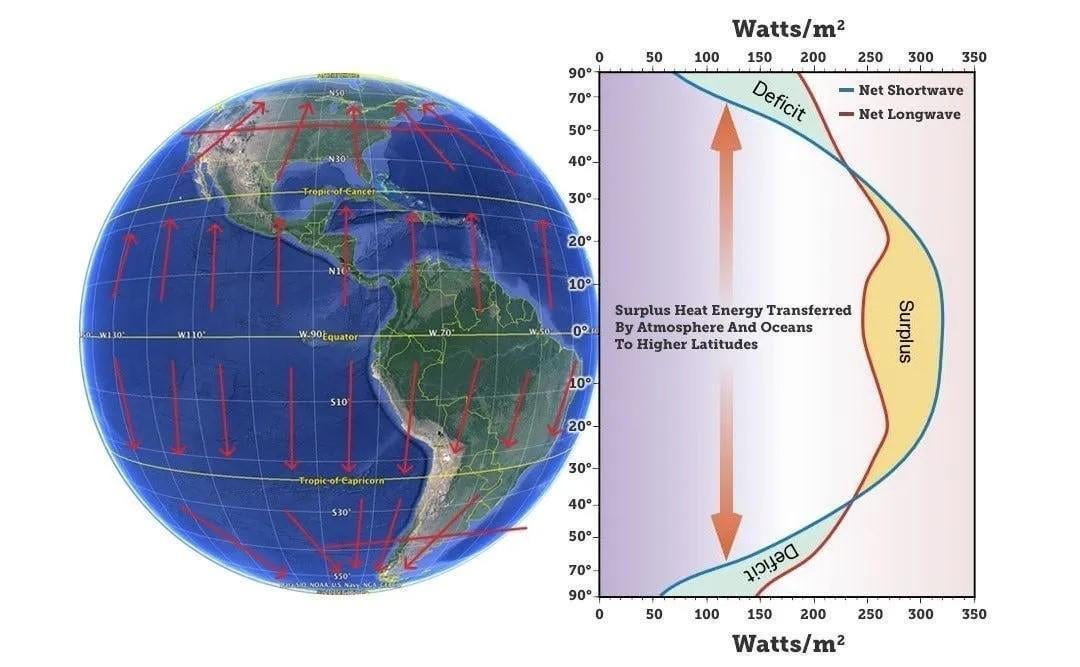
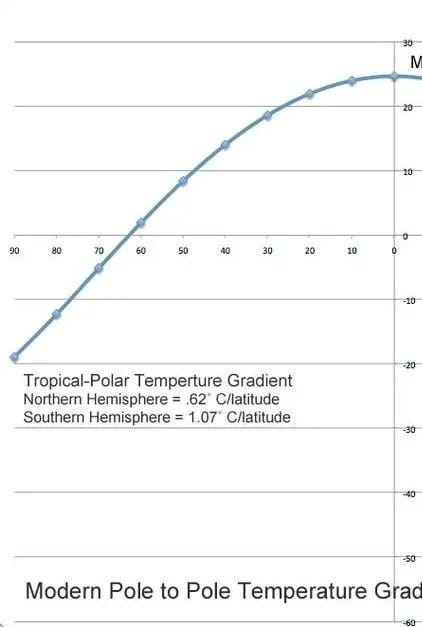
Every few months we get new perspectives and solidifications of understanding. I’ve been aware of your writings now for approximately 2 years. Every single thing has turned out to be worse than imagined. The mainstream structure of thinking and analysis heavily relies upon using arbitrary, psychologically safe things like 1.5C or 2050/2100/etc. Arbitrary places that generate continued hope and attachment to a system that’s already effectively driven us extinct. We’re the latent ghost phase. The current configuration of the biosphere will end. We will end. Most life will end.
Stuff will come after. Millions of years into the future the oceans may level out and allow for coral and more again.
Until then, this is our hospice. A handful of decades left at best. A handful of years left for the current golden age of the privileged. Everyone else has basically already collapsed.
The fever dream phase is still here. The party is still rocking. But you can hear the monsters starting to gather outside.
132x of the rate that causes one of the largest extinction events ever. And we think we are gonna survive this. lol. 🫠
Richard, You are right. AND it is even worse. If we tally up the other global warming gases we are now over 550 ppm CO2(e). Then add in albedo reduction and decreasing aerosols and today we are at about 750 ppm CO2(e). And next year we will reach about 820 ppm CO2(e) (mostly due to declining aerosols and reduced albedo).
Then in in the next decade we go over 1,800 ppm CO2(e). To say that is unprecedented is grossly insufficient. And - mother nature hasn't yet had her say. Sigh.